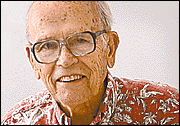Advertisement - Click to support our sponsors.


Hawaii’s World
A high-level policy conference at the East-West Center last week heard a grim possible scenario for the future: a new Cold War with multiple players threatening rivals with missiles that are hard to defend against. Missile threat predicted
for 21st centuryNorth Korea's capability is a case in point. But Israel, Syria, Iraq, Iran, India, Pakistan and China are in the act, too -- not to mention the U.S. and Russia.
Missiles aren't cheap to build. But they are a lot cheaper than the defenses against them.
The defense hasn't worked yet in U.S. tests.
Even a workable counter-rocket system to destroy an incoming missile such as the U.S. is considering in Alaska could destroy only six or so at most, given present capability. A saturation attack by hundreds couldn't be stopped.
Today's focus is on a surface-based rocket destroying an incoming surface-based rocket.
Future defenses could call for rockets in orbit, then more rockets -- potential annihilation circling us every hour.
Rockets of mass destruction trump geography. They can destroy defense installations, cities, closely grouped standing armies. They make armies less significant.
Yes, enemy rocket launch sites can be destroyed, but only by an act of war. North Korea has posed that dilemma.
It is what the Cuban missile crisis was all about. There, the U.S. and the U.S.S.R. went eyeball-to-eyeball before both sides blinked. The Soviets pulled back from Cuba. We agreed that in a few months we would take our missiles out of Turkey on the border of the U.S.S.R.
The missile threat as outlined at the East-West Center gives great impetus to a strategy now actively promoted by the U.S. -- international confidence building by promoting openness, consultation and structures for peaceful resolution of differences. This, too, was outlined.
On hand at what was called the second annual East-West Center Senior Policy Seminar were 33 defense bigwigs from eight nations. They talked not for attribution but with a few media representatives present. Among them were seven participants from Japan, four from China, none from Taiwan except for an observer, and single representatives from Australia, India, Indonesia, Russia and Thailand.
U.S. and East-West Center participants rounded out a total of 33 that included former Defense Secretary William Perry for two of the three days plus our ambassadors to China, Japan and South Korea, plus academics.
THE missile threat gives extra importance to efforts pursued in Hawaii by the East-West Center, by the U.S. Pacific Command, and by the the federally sponsored Asia-Pacific Center for Security Studies, just relocated to Fort DeRussy, to try to build communications, confidence and trust among Asia-Pacific nations so that reliance on force can be minimized, a very last resort.
A much-used term was that nations should be "transparent" or open about the forces they have. The goal of all such forces is assumed to be national defense, not regional aggrandizement. The latter surely would provoke a united, even a United Nations, response.
A by-product of the conference, most certainly, was that social contacts among the conferees, who were housed at Hilton Hawaiian Village, might help promote this trust. Having each other's phone and fax numbers and email addresses won't hurt either.
For the trust approach to gain adherence, primacy must be placed on the advantages for all peoples in the Asia-Pacific region in avoiding war in order to take advantage of the opportunity offered by technological development to improve life for all.
Failure could make the 21st century as destructive as the 20th -- or worse.
A.A. Smyser is the contributing editor
and former editor of the the Star-Bulletin
His column runs Tuesday and Thursday.